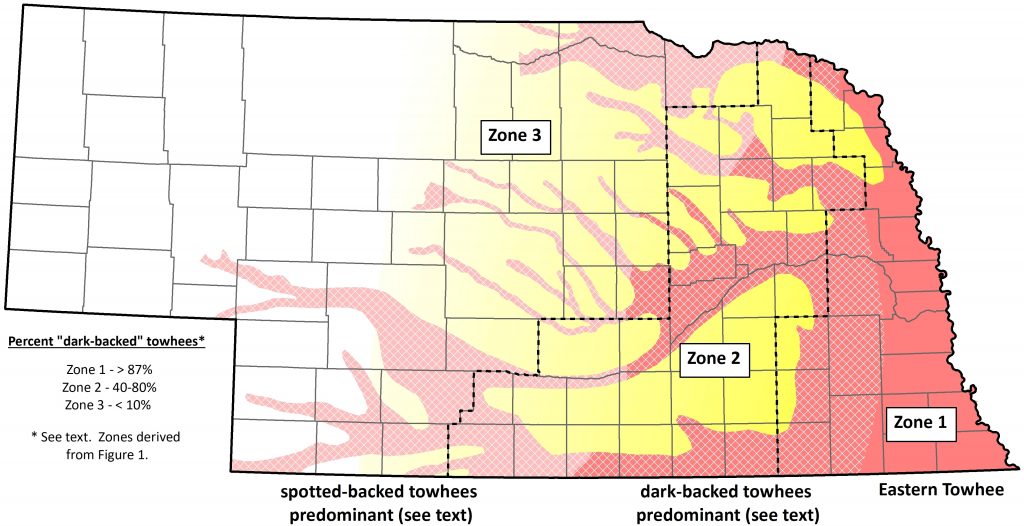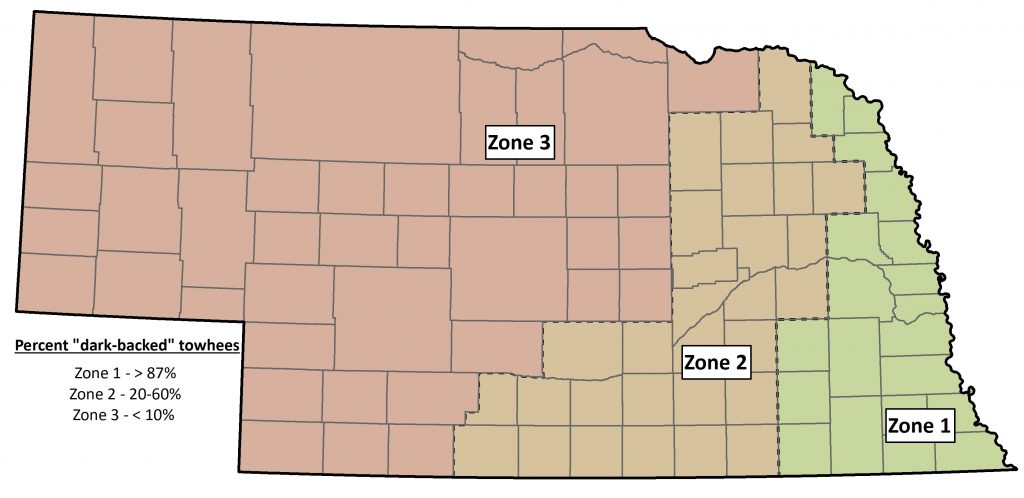Pipilo erythrophthalmus erythrophthalmus
Status: Common regular breeder extreme southeast, rare casual elsewhere. Common regular spring and fall migrant within and near breeding range, uncommon elsewhere east and east central, rare casual west central and west. Rare casual winter visitor southeast.

Documentation: Specimen: UNSM ZM7238, 19 Jan 1900 Saltillo, Lancaster Co.
Taxonomy: Four subspecies are recognized (AviList 2025): erythrophthalmus, breeding from Manitoba to Maine and south to Oklahoma and Virginia, wintering to south Texas and Florida, canaster, breeding from Louisiana to Tennessee south to South Carolina and Florida, wintering in South Carolina and Florida, rileyi, resident from Alabama and southeast Virginia to northern Florida, and alleni, resident in peninsular Florida.
Nebraska birds belong to the widespread subspecies erythrophthalmus.
See https://birds.outdoornebraska.gov/spotted-x-eastern-towhee-hybrid/ for discussion of relationships in Nebraska with Spotted Towhee.
Spring: Mar 9, 10, 12 <<<>>> summer
The above dates may have been wintering birds; earlier dates are discussed in Winter (below).
Migration peaks in late Apr-early May. Ludlow (1935) listed it as a common migrant in Webster Co, occurring in the period 5 Apr-9 May, and a specimen, HMM 2022, was taken at Inland, Clay Co 3 May 1915.
Migrants, including occasional birds that resemble phenotypically pure Easterns, are reported regularly westward to Keith Co in the Platte River Valley and northeastward through the Sandhills to northeast Nebraska near Yankton, South Dakota. Phenotypic silent male Eastern Towhees were at Lake McConaughy, Keith Co 21 Apr 2007, in Custer Co 29 Mar 2010, and in Dundy Co 3 May 2022.
In the Panhandle there were several records of phenotypic males 30 Apr-21 May from 2013-2017. These are the only spring Panhandle records.
- High counts: 24+ at Ponca SP, Dixon Co 2 May 2009, 20 at Wilderness Park, Lancaster Co 13 May 2021, 19 at DeSoto NWR, Washington Co 13 May 2023, and 19 along Homestead Trail, Gage Co 4 May 2024.
Summer: Greenlaw (2020, Figure 2) summarized relative distributions of Eastern and Spotted Towhees; Eastern Towhee occurs predominantly in the southeast. However, as shown in figure 1, and discussed in more detail in the Spotted Towhee species account at https://birds.outdoornebraska.gov/spotted-towhee, there is considerable overlap with “spotted-backed” towhees, most notably in Zone 2.

Reports of birds that resemble phenotypically pure Easterns near the western and northern edges of their “genetic range” (Greenlaw 2020) and shown in Zone 3 in Figure 1 include 9 Jun 2001 at Enders Reservoir, Chase Co, one that “looked and sounded” like this species at Scotts Bluff NM, Scotts Bluff Co 17 Jul 2013, a pair in Dawson Co 6 Jul 2015 and another there 13 May 2004, Thomas Co 25 Jun 2015, two singing “drink your tea” at NNF Bessey, Thomas Co 30 Jun 2019, two singing typical Eastern songs there 5 Jul 2020 (eBird.org recording), 26 Jun 2015 near NNF McKelvie, Cherry Co 26 Jun, two on 14 Jun 2016 Fort Niobrara NWR, Cherry Co, and a male paired with a Spotted Towhee in Keya Paha Co 2 Aug 2009.
- Breeding phenology:
- Nest building: 3 May- 25 Jun
Eggs: 8 May- 1 Sep (Mollhoff 2022)
Nestlings: 4 Sep
Fledglings: 24 Jun-12 Sep
Fall: summer <<<>>> Oct 27, 30, 30
Later dates are 1-3 Nov 2001 Ponca SP, Dixon Co, and 2-6 Nov 2018 Omaha, Douglas Co. For later dates see Winter.
Most depart by the end of Oct. The 26 at Two Rivers SP, Douglas Co 5 Oct was indicative of peak fall movement. There are numerous Dec reports in the southeast, but most depart the state by Jan-Feb.
Winter: The only documented record of overwintering is surprisingly, of one wintering at a Dixon Co feeder 25 Nov 2022 through 5 Apr 2023 (Jan Johnson, David Cunningham, photographs), although at least single reports have occurred most winters in the southeast.
There are 21 records 7 Nov-8 Mar, all in the east; two in Nov, six in Dec, two in Jan, eight in Feb, and three in Mar. Of the 21 winter records, six are from Dixon Co, the others from the southeast.
During the 24 years of CBCs 1991-1992 through 2015-2016, Eastern Towhees were reported 13 different years with a total of 20 individuals.
Late dates for northerly locations are of one on the Norfolk CBC 17 Dec 1994, one at Big Bear Park, Thurston Co 26 Dec 2024, and a male at Ponca SP, Dixon Co 11 Jan 2009.
Winter 2019-2020 had a number of reports, including as many as seven on the Indian Cave SP CBC 14 Dec, while farther north than usual were one in Dakota Co 25 Jan and two at Ponca SP 15 Feb, as well as one on the Ames CBC, Dodge Co 17 Dec. At least two were at Fontenelle Forest, Sarpy Co 2019-2020; females, possibly the same bird, were reported 27 Dec and 4 Jan, and a male 22 Feb.
Abbreviations
CBC: Christmas Bird Count
HMM: Hastings Municipal Museum
NNF: Nebraska National Forest
NM: National Monument
NWR: National Wildlife Refuge
SP: State Park
UNSM: University of Nebraska State Museum
Acknowledgement
Photograph (top) of a Eastern Towhee at Fontenelle Forest, Sarpy Co 5 May 2011 by Phil Swanson.
Literature Cited
AviList Core Team, 2025. AviList: The Global Avian Checklist, v2025. https://doi.org/10.2173/avilist.v2025.
Greenlaw, J.S. 2020. Eastern Towhee (Pipilo erythrophthalmus), version 1.0. In Birds of the World (P. G. Rodewald, Editor). Cornell Lab of Ornithology, Ithaca, NY, USA. https://doi.org/10.2173/bow.eastow.01.
Ludlow, C.S. 1935. A quarter-century of bird migration records at Red Cloud, Nebraska. NBR 3: 3-25.
Mollhoff, W.J. 2022. Nest records of Nebraska birds. Nebraska Ornithologists’ Union Occasional Paper Number 9.
Recommended Citation
Silcock, W.R., and J.G. Jorgensen. 2025. Eastern Towhee (Pipilo erythrophthalmus). In Birds of Nebraska — Online. www.BirdsofNebraska.org
Birds of Nebraska – Online
Updated 23 Jul 2025
